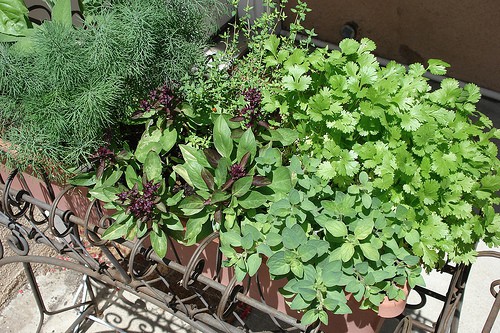it’s my pleasure to welcome Fern from Life on the Balcony for a guest post on starting a kitchen herb garden. A kitchen herb garden is healthy and frugal, and what could be more efficient than reaching out of your window to pluck a few leaves for the sauce? Be sure to check out Fern’s site about planting in all containers and conditions. Even if you never start a garden, you will still enjoy her beautiful photos.
It’s Money-Saving Monday at Cooking Manager.Com, and
Starting a kitchen herb garden is a great way to have your favorite herbs on hand for a fraction of the price it would cost to buy them at the market. Herbs are easy to grow and will happily produce healthy plants in smallish pots on your windowsill, balcony, or patio.
The first thing to decide is what herbs to grow. You should only grow herbs that you’ll actually use, so there is no list of “must grow” herbs. Grow whatever you like cooking with! Of course, it’s fun to try new herbs, and the best way to do that is to pick herbs that are commonly used in the types of cuisine you enjoy cooking. For example, if French cuisine is your thing, try bay, parsley, tarragon and thyme (the classic “bouquet garni” herbs). Another way to expand your herb horizons is to try unusual varieties of herbs you know you like, such as ‘Purple Petra,’ basil or ‘Lemon Variegated’ thyme.
Don’t be discouraged if you can’t find the herb plants you plan on growing, almost all are easy to find as seeds and equally easy to grow that way. I think it’s best to grow at least two of each herb. That way you’ll have plenty on hand, even after you’ve used some. If you’re starting your herbs from seed, start double the amount you want to end up with, just in case. If all of them sprout and live until adolescence, you can always give the extras to friends.
Most herbs like fast draining soil. You should look for a bag marked “potting soil” (don’t use dirt from your garden!). A fast draining soil will usually have plenty of perlite (the small white “pebbles” in potting soil). Perlite helps water drain quickly and keeps the soil aerated, which is great for happy herbs.
Next you’ll need some pots. One that is at least six inches wide should be fine. Be sure that it has a drainage hole in the bottom. There is no need to spend a lot of money on your pots. You can even use found objects or build your own window box from scraps of wood. Just remember to punch holes in the bottom.
After you’ve picked out your herbs, gotten your pots and soil together, it’s time to find a good spot for them to grow. The most important part of picking a spot is finding a place with at least six hours of direct sunlight. The second thing to consider about the location is convenience. If your herbs are tucked away in some difficult to get to spot, you won’t use them as much. A window box under your kitchen window, your back steps, a corner of your balcony, or even more convenient, your kitchen windowsill, are all good spots.
Pot up your herbs about an inch below the lip of the pot. Water them whenever the soil feels dry. During the summer, this will probably be every day. Give each pot enough water that some drains through the bottom. It’s not absolutely necessary to fertilize herbs, but they will do their best with a fertilizer marked 5-10-5 given once a month. Do not over fertilize though, as it will reduce the essential oils that make herbs smell and taste so good.
For further info on growing herbs, check out some of these websites:
- Growing Herbs for the Home Gardener: Lots of information about growing specific herbs. Contains a handy table listing herbs in alphabetical order by their common name.
- Herb Society of America: Their “Resources” and “About Herbs” sections contain lots of information about growing herbs in general and also have specific herb profiles.
- Herb Gardening Guru: Lots of helpful information about the history of herbs, harvesting herbs, growing them in containers, etc.
Fern, thank you for the gardening inspiration. For more information and photographs, see Fern’s blog, Life on the Balcony.


I love herb gardening. Unfortunately, our local groundhog loves it, too. I just installed a Solar Pest Repeller near my basil. And I planted some dill in pots on my front porch.
Good advice on not using soil from the garden. I have this big box of “stuff” (I forget the name) that I can use both as potting soil and as seed starter.
I like the formatting of this post. Nice.